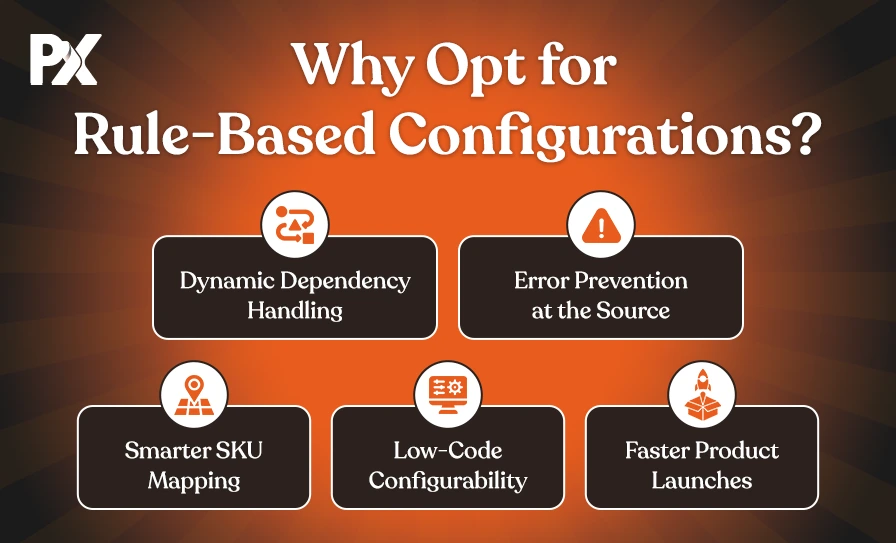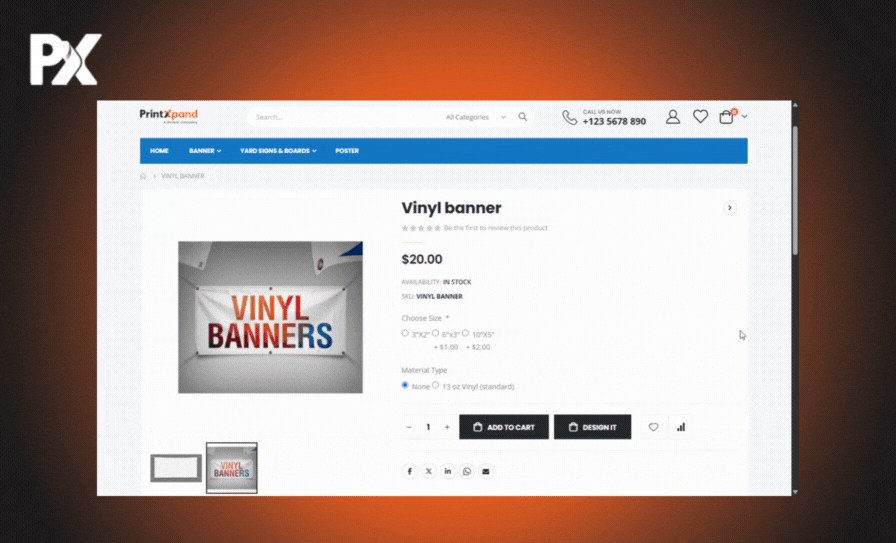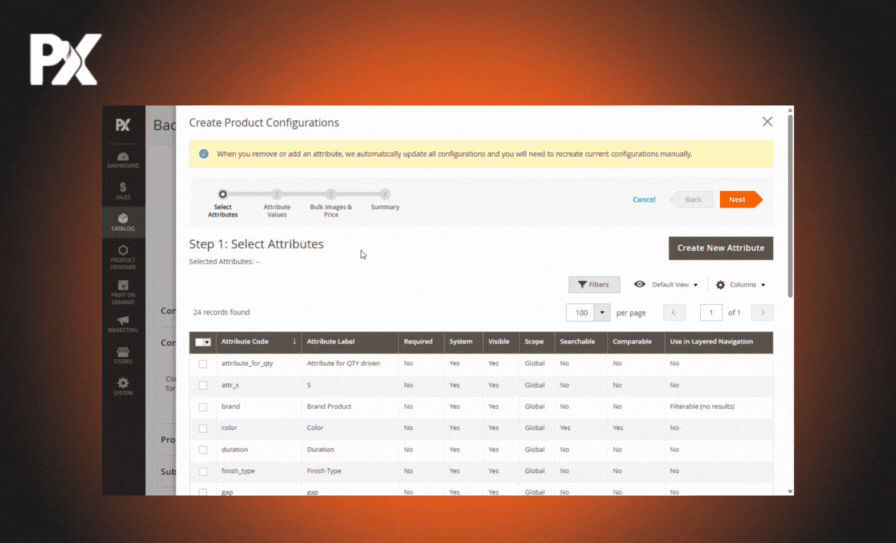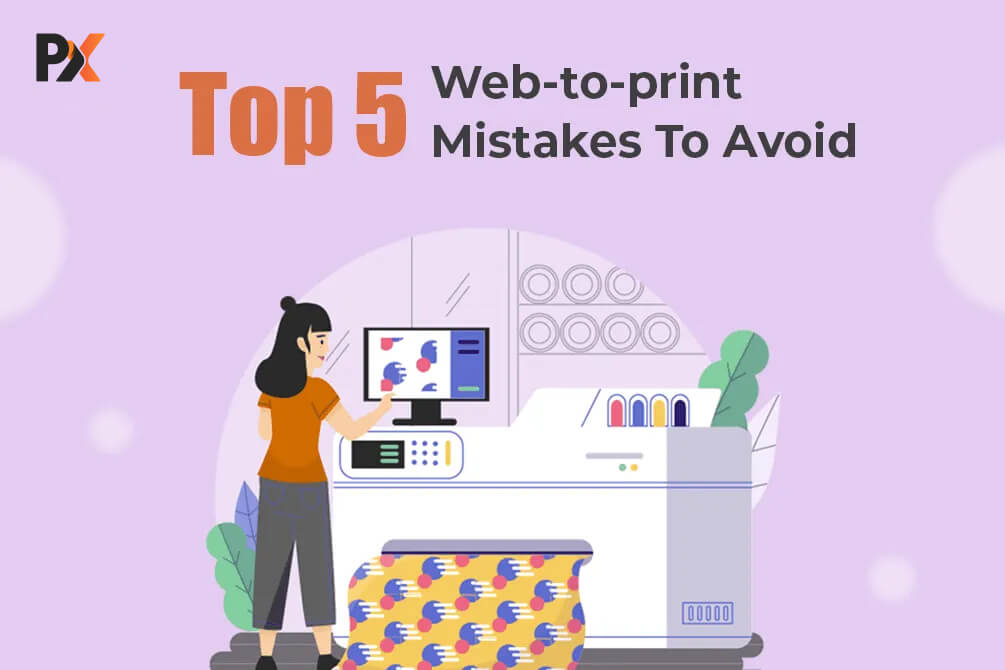Summary
- Rule-based printing simplifies complex wide-format product setups by guiding users through only valid options, eliminating costly misconfigurations that cause reprints, delays, and customer dissatisfaction.
- Modern print workflow automation helps print shops manage thousands of custom combinations in large format printing, ensuring that incompatible options (for example, mesh on small banners or grommets on rigid materials) are automatically filtered out.
- With dynamic logic and low-code tools, rule based automation enables faster setup changes, smarter SKU mapping, and efficient print job management, freeing skilled staff from repetitive validations.
- Automated configuration prevents wide-format printing errors at the source by disabling invalid selections in real-time, thereby improving order accuracy and enhancing the overall user experience.
- Use of printing automation software and a strong print management system allows scalable handling of seasonal products, finishing rules, and design tool integrations vital for error-free printing large scale projects.
- Real-world use cases also prove how print shop workflow software with rule logic can cut support tickets by 80%, reduce rework, and transform how large format printing is delivered profitably.
You are losing time and money even before the job hits the press
Nearly 50% time used to produce a job is typically spent before it even reaches the press, caused by approval bottlenecks, incorrect specs, or configurations that never should’ve made it past quoting.
Sound familiar?
Your team is ready to hit print, but the job’s stuck in limbo, waiting on changes that could’ve been flagged earlier. That delay? That’s the real cost. Not in reprints, but in lost time, idle presses, and the risk of refunds when something wasn’t actually feasible to begin with.
In wide-format printing, every job is a custom configuration of materials, finishes, and sizes. You’re managing hundreds of variables, and the pressure to deliver quickly doesn’t leave room for error.
Handling all of this is already a headache, and trying to manually monitor every detail only makes it worse. It costs your business time, money, and customer trust.
Put all those challenges together, and it’s clear: What the wide-format industry needs isn’t faster printing. It’s smarter ordering systems that catch problems before they become production delays.
So, how do you get there? It starts with rethinking how your team handles complexity before the print button is even pressed.
Let’s discuss this further.
Challenges and How Rule-Based Configurations Solve Them
The modern large-format printing industry is facing a configuration crisis, and it’s quietly costing print businesses time, money, and customer trust. As more customers demand personalized print products, traditional methods of product selection like spreadsheets, static forms, or manual checks simply can’t keep up with the level of customization now expected.
That’s why more print service providers are turning to rule-based configurations, not just to speed things up, but to reduce errors and take pressure off their teams by automating validation at the setup stage.
The Wide Format Product Configuration Challenges
Print service providers today are dealing with four major challenges that affect how efficiently they can operate in a wide-format environment.
Too Many Product Combinations to Manage
Even a single wide-format product, like a banner, can result in thousands of possible combinations — different sizes, substrates, ink types, finishes, hemming options, mounting hardware, and edge treatments. This complexity quickly becomes unmanageable, both for your internal teams and for customers trying to place orders without making mistakes.
Without a smart system to guide valid combinations, your team ends up spending time answering questions, fixing errors, and manually checking configurations — all of which slows down your workflow.
High Risk of Customers Selecting Incompatible Options
Since most customers aren’t familiar with print production requirements, they often choose options that look fine on the surface but aren’t actually compatible. For example, it’s common to see customers choose mesh materials for small-format prints, request grommets on rigid substrates, or select double-sided printing on wind-slotted vinyl. In reality, all of these are incompatible or impractical to produce.
Without built-in logic to filter out invalid combinations in real time, these mistakes often go unnoticed until the job reaches prepress, resulting in delays or reprints.
Manual Validation Is Time-Consuming and Expensive
When misconfigured jobs come through, your team has no choice but to step in. Experienced staff must spend anywhere from 15 to 30 minutes per order reviewing the specifications, identifying conflicts, contacting the customer, and suggesting changes.
While it may seem manageable at low volumes, this manual intervention creates a major bottleneck when you’re dealing with dozens or maybe hundreds of custom orders per day.
What’s worse, this task usually falls on your most skilled employees, the very people whose time should be spent on high-value production tasks and not chasing spec corrections.
Misconfigurations Lead to Reprints and Customer Frustration
Not every error is caught in time. When incompatible selections make it past the prepress stage, they often lead to misprints, missed delivery deadlines, and the need for rush shipping, directly reducing your profit margins. In many print shops, these issues can account for 15–25% of total operational losses, especially when they occur on repeat orders.
In addition to the financial loss, your team also has to deal with refund requests, frustrated customers, and broken trust, which makes it harder to recover from.
The Solution? Rule-Based Configuration

Rule-based configuration takes the guesswork out of wide-format product setup. Instead of letting customers choose from an endless list of combinations—some of which may not even be possible to produce—it gives them a guided way to configure their order based on actual production rules. This is where rule based printing plays a critical role in improving accuracy.
The system uses built-in logic to ensure every choice a customer makes leads to a valid, compatible outcome. It reduces confusion on the front end and prevents costly wide-format printing errors before they happen.
Dynamic Dependency Handling
At the core of rule based automation is dynamic dependency handling. This means the system understands how different large format printing specifications relate to each other and adjusts the available options in real time as selections are made.
For example, when a customer selects a large banner size, the system automatically filters the material list to show only heavy-duty substrates that can handle the size and wind load. If mesh is selected for wind resistance, double-sided printing is disabled right away because mesh can’t support ink on both sides. This is particularly helpful when configuring complex, large format banner printing requirements.
The same logic applies to finishing. If someone selects grommets, pole pockets are removed from the list because those two finishing types can’t be used together. This way, the customer only sees options that make sense for the type of job they’re configuring. In short, it proves that rule based automation is an essential feature in any print shop workflow software.

Video demonstrating how selecting an option dynamically filters or hides related and dependent printing choices, helping prevent production errors in wide format printing.
Error Prevention at the Source
The biggest benefit of rule-based setup is that it stops incorrect combinations from ever reaching the production stage. Instead of just hiding incompatible options, the system disables them in the interface, giving customers clear visual feedback on what’s allowed and what isn’t. This level of print workflow automation helps prevent rework and production delays.
The system can handle more complex scenarios, like only showing wind slits for mesh banners above a certain size or limiting mounting hardware based on both finishing style and material thickness. All of this happens automatically in the background, reducing the risk of large scale printing jobs going wrong.
Smarter SKU Management
Without automation, print shops often have to create a separate SKU for every possible combination of size, material, and finishing. That leads to thousands of entries, manual price mapping, and a catalog that’s hard to manage without a robust print management system.
With rule based automation, valid SKUs are created on the fly, based on the selections customers make. You don’t need to build out every variation manually. All that needs to be done is to define the rules, and the system does the rest. This makes print job management much more efficient and scalable.
You can also apply pricing rules based on material type, size ranges, finishing complexity, or any other criteria without needing to maintain separate entries for each scenario.

Video demonstrating how selecting various combinations dynamically creates different SKUs.
Low-Code Setup for Teams
One of the biggest advantages of modern print workflow automation tools is that they don’t require developers to maintain every rule. Through a low-code setup, your non-technical team members can update product logic, add new options, or make changes to existing dependencies without writing any code.
This makes it easy to launch seasonal products, update material options, or respond to production changes without slowing things down. Whether it’s your production team updating finishing options based on equipment availability or your sales team introducing a new product configuration, these changes can be made instantly without needing IT support. This kind of flexibility makes managing large format printing much more responsive to business needs.
Faster Product Launches
When you combine dynamic rules with low-code flexibility, you can launch new products much faster. Instead of spending weeks setting up every option and combination manually, your team just defines the logic once, and the system handles the rest using printing automation software.
This kind of speed is especially useful during busy seasons or when reacting to a new customer need. Whether you’re introducing a new rigid substrate for outdoor signage or adding custom finishing options for a retail display job, you can go live quickly, without the risk of setup errors or production delays.
At the same time, it also opens up opportunities to expand your offerings through design tool integrations. For example, print shops can easily support custom products, like posters and signage, by connecting their workflow to poster design software or sign design software. This ensures that even new design-driven formats benefit from the same rule-based logic and error prevention applied across all your wide-format product lines.
Expert Tips on Getting the Most Out of Rule-Based Configuration
Implementing rule based printing and print workflow automation is a powerful step forward. But like any production system, its effectiveness depends on how well it’s planned, configured, and refined over time. To help you get the best results from day one, here are a few expert tips based on real-world examples!
Step 1: Identify the Right Problems to Solve First
Start by mapping out your current configuration pain points. Talk to your prepress operators, production staff, and customer service teams. Where do mistakes happen most often? Are customers frequently choosing finishes that don’t work with certain materials?
For example, if your team constantly deals with customers selecting lamination for recyclable kraft paper, that’s a clear rule to automate first. By focusing on the errors that cost your team the most time or cause the most rework, you’ll get maximum value from your first phase of rule-based logic.
Step 2: Build a Blueprint for Your Rules
Once you have identified your problem areas, work with your printing automation software provider to translate them into system rules. Treat this like building a configuration blueprint, something that reflects real production logic.
For instance:
If substrate = mesh AND size < 2 ft → block that option.
Rules like these are simple but powerful, and they prevent your team from having to manually fetch and fix issues every time they occur.
Step 3: Use Real Data to Improve the System
Even after implementation, your rule-based system should evolve. Review customer support ticket trends quarterly. Are certain errors still making it through? Are customers confused at any particular step?
Use this data to improve your rule sets and update interface guidance. This not only keeps errors down but also creates a smoother ordering experience over time, one that continues to reduce manual intervention as your product catalog grows.
How Rule-Based Printing Solves the Common Pitfalls Across Industries
The practical value of rule-based printing becomes even clearer when applied to real production environments. Across wide-format, packaging, commercial, and signage applications, print workflow automation has helped print businesses reduce errors, improve order accuracy, and save countless hours of manual work.
Outdoor Banners (Wide Format)
A large format printing company struggled with customers frequently selecting mesh material for small banner sizes, creating orders that couldn’t be fulfilled as specified. Small mesh banners lacked structural integrity and didn’t provide an adequate print surface for detailed graphics. Customer service teams spent countless hours calling customers to discuss alternatives, often resulting in order cancellations or significant delays.
After implementing rule based automation, the system now automatically restricts mesh selection to medium and large banner sizes. When customers select small dimensions, mesh options disappear from the material choices, guiding them toward appropriate vinyl substrates. This simple rule led to an 80% drop in support tickets related to invalid configurations and improved customer satisfaction by helping users avoid setup mistakes.
Corrugated Boxes (Packaging)
A packaging printer faced recurring issues with customers selecting lamination finishes for recyclable kraft paper substrates, combinations that weren’t technically feasible due to recycling contamination concerns. These incompatible selections led to production delays, customer education calls, and frequent order modifications that disrupted workflow efficiency.
Today, they use a rule-based engine that automatically disables lamination when kraft paper is selected. Instead, it shows only compatible, eco-friendly coating options.
This proactive filtering has eliminated the need for rework, sped up approvals, and allowed the team to focus on more strategic tasks instead of fixing basic configuration errors.
Custom Catalogs (Commercial)
A commercial printer experienced frequent problems with customers selecting perfect binding for thin booklets under 30 pages, resulting in structural failures where covers separated from content blocks. These binding failures created quality issues, customer complaints, and expensive reprints that affected the business’s profit margins.
However, with the help of the intelligent print job management, the system now adjusts binding options automatically based on page count inputs. Thin booklets default to saddle-stitching options, while perfect binding only appears for publications with sufficient page counts to support the binding method. This automatic adjustment increased customer satisfaction while dramatically reducing binding-related complaints and reprints.
Floor Graphics (Signage)
A signage company dealt with safety concerns when customers selected high-gloss laminate for floor graphics in high-traffic areas, creating slip hazards that posed liability risks. These material mismatches led to customer returns, safety compliance issues, and potential legal exposure that threatened business operations.
But, with the new system, they can now filter material and finish options based on intended use case inputs. When customers specify high-traffic floor applications, only slip-resistant finishes appear in the selection interface. This safety-focused filtering improved compliance records while reducing returns and protecting both customers and the print provider from safety-related incidents.
Thinking about expanding into large format printing or refining your existing setup? Check out our guide on launching and scaling a successful wide-format print business.
Why This Approach Works
Rule based printing works because it directly addresses the most common challenges faced in wide-format and large format printing. This comes in handy specifically when the business has to manage high-volume, customizable, high-variation product workflows.
User-Centric
Instead of overwhelming customers with unlimited combinations, rule-based configuration guides them through a logical, step-by-step selection process. It eliminates confusion by only showing options that are compatible with each other. This makes customers feel supported, not restricted, leading to fewer abandoned carts and higher order accuracy.
Built for Print Complexity
This approach goes far beyond basic configuration tools. It understands the unique dependencies between substrates, inks, finishing processes, and equipment constraints that are specific to print production. It takes into account all the technical realities that generic eCommerce platforms can’t handle, making it a better fit for the operational demands of wide-format print businesses.
Low Technical Overhead
Rule based automation is designed for flexibility. Non-technical team members can set up or adjust product logic without developer support. That means your marketing team can introduce seasonal offerings or promotional items. Your production manager can update configuration rules based on equipment maintenance, new substrates, or supply chain changes without delays.
Scalable
Regardless if you are managing 10 core products or 300+ variations, the same rule-based framework adapts seamlessly. From small shops with a focused offering to large operations handling complex print job management across multiple formats and finishing options, it scales with you without needing major changes.
Final Thoughts
For wide-format print houses, the biggest risk isn’t just limited to printing itself! It’s in everything that happens before a job hits the press. One wrong spec, one incompatible material, or one missed rule in the configuration process can lead to reprints, delays, and lost revenue.
By using rule based printing and print workflow automation, you are speeding up setup in addition to building a smarter, more scalable operation that catches mistakes before they happen. The entire tech improves order accuracy and helps your team focus on what really matters: delivering high-quality work on time and with fewer interruptions.
In short, rule based printing configurations are just a better way to run your print business.
So, are you ready to eliminate wide-format printing errors and boost your profitability? Discover how to reduce support tickets by up to 80%, eliminate costly reprints and delays, automate complex product configurations, and guide customers to perfect selections every time.
All product and company names are trademarks™, registered® or copyright© trademarks of their respective holders. Use of them does not imply any affiliation with or endorsement by them.




